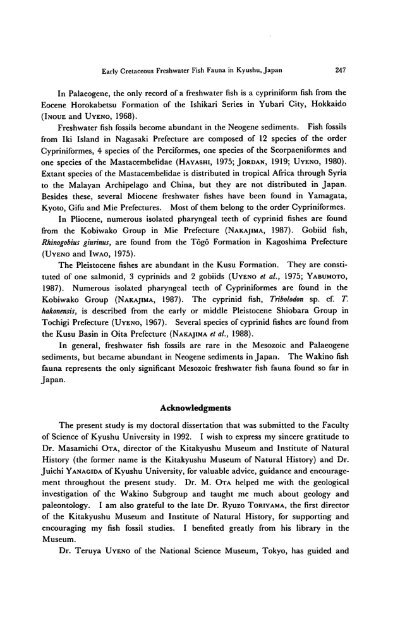Early Cretaceous Freshwater Fish Fauna in Kyushu, Japan
Early Cretaceous Freshwater Fish Fauna in Kyushu, Japan
Early Cretaceous Freshwater Fish Fauna in Kyushu, Japan
Create successful ePaper yourself
Turn your PDF publications into a flip-book with our unique Google optimized e-Paper software.
<strong>Early</strong> <strong>Cretaceous</strong> <strong>Freshwater</strong> <strong>Fish</strong> <strong>Fauna</strong> <strong>in</strong> <strong>Kyushu</strong>, <strong>Japan</strong> 247<br />
In Palaeogene, the only record of a freshwater fish is a cypr<strong>in</strong>iform fish from the<br />
Eocene Horokabetsu Formation of the Ishikari Series <strong>in</strong> Yubari City, Hokkaido<br />
(Inoue and Uyeno, 1968).<br />
<strong>Freshwater</strong> fish fossils become abundant <strong>in</strong> the Neogene sediments. <strong>Fish</strong> fossils<br />
from Iki Island <strong>in</strong> Nagasaki Prefecture are composed of 12 species of the order<br />
Cypr<strong>in</strong>iformes, 4 species of the Perciformes, one species of the Scorpaeniformes and<br />
one species of the Mastacembelidae (Hayashi, 1975; Jordan, 1919; Uyeno, 1980).<br />
Extant species of the Mastacembelidae is distributed <strong>in</strong> tropical Africa through Syria<br />
to the Malayan Archipelago and Ch<strong>in</strong>a, but they are not distributed <strong>in</strong> <strong>Japan</strong>.<br />
Besides these, several Miocene freshwater fishes have been found <strong>in</strong> Yamagata,<br />
Kyoto, Gifu and Mie Prefectures. Most of them belong to the order Cypr<strong>in</strong>iformes.<br />
In Pliocene, numerous isolated pharyngeal teeth of cypr<strong>in</strong>id fishes are found<br />
from the Kobiwako Group <strong>in</strong> Mie Prefecture (Nakajima, 1987). Gobiid fish,<br />
Rh<strong>in</strong>ogobius giur<strong>in</strong>us, are found from the Togo Formation <strong>in</strong> Kagoshima Prefecture<br />
(Uyeno and Iwao, 1975).<br />
The Pleistocene fishes are abundant <strong>in</strong> the Kusu Formation. They are consti<br />
tuted of one salmonid, 3 cypr<strong>in</strong>ids and 2 gobiids (Uyeno et al., 1975; Yabumoto,<br />
1987). Numerous isolated pharyngeal teeth of Cypr<strong>in</strong>iformes are found <strong>in</strong> the<br />
Kobiwako Group (Nakajima, 1987). The cypr<strong>in</strong>id fish, Tribolodon sp. cf. T.<br />
hakonensis, is described from the early or middle Pleistocene Shiobara Group <strong>in</strong><br />
Tochigi Prefecture (Uyeno, 1967). Several species of cypr<strong>in</strong>id fishes are found from<br />
the Kusu Bas<strong>in</strong> <strong>in</strong> Oita Prefecture (Nakajima et al., 1988).<br />
In general, freshwater fish fossils are rare <strong>in</strong> the Mesozoic and Palaeogene<br />
sediments, but became abundant <strong>in</strong> Neogene sediments <strong>in</strong> <strong>Japan</strong>. The Wak<strong>in</strong>o fish<br />
fauna represents the only significant Mesozoic freshwater fish fauna found so far <strong>in</strong><br />
<strong>Japan</strong>.<br />
Acknowledgments<br />
The present study is my doctoral dissertation that was submitted to the Faculty<br />
of Science of <strong>Kyushu</strong> University <strong>in</strong> 1992. I wish to express my s<strong>in</strong>cere gratitude to<br />
Dr. Masamichi Ota, director of the Kitakyushu Museum and Institute of Natural<br />
History (the former name is the Kitakyushu Museum of Natural History) and Dr.<br />
Juichi Yanagida of <strong>Kyushu</strong> University, for valuable advice, guidance and encourage<br />
ment throughout the present study. Dr. M. Ota helped me with the geological<br />
<strong>in</strong>vestigation of the Wak<strong>in</strong>o Subgroup and taught me much about geology and<br />
paleontology. I am also grateful to the late Dr. Ryuzo Toriyama, the first director<br />
of the Kitakyushu Museum and Institute of Natural History, for support<strong>in</strong>g and<br />
encourag<strong>in</strong>g my fish fossil studies. I benefited greatly from his library <strong>in</strong> the<br />
Museum.<br />
Dr. Teruya Uyeno of the National Science Museum, Tokyo, has guided and

















